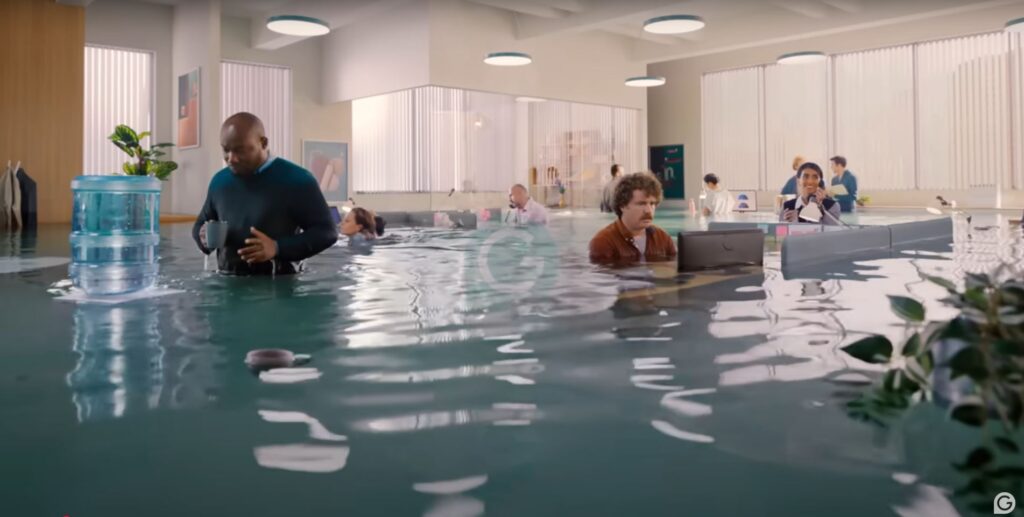Ever seen an ad where an office is literally underwater?

If you’ve watched Grammarly’s “underwater office” commercial, you’ll know exactly what I’m talking about. The ad doesn’t just grab attention—it’s a masterclass in storytelling, creativity, and effective communication.
Here’s why the ad works so well and the lessons every marketer, entrepreneur, and creative can take from it.
What Happens in the Ad?
The ad opens with a surreal and eye-catching scene: employees are working in an office that’s completely submerged underwater. Papers float, laptops bubble, and workers struggle to perform basic tasks while literally drowning in their environment.
The message? Work can feel overwhelming, like you’re drowning in tasks. Grammarly positions itself as the tool that helps you “blow your workload out of the water,” making communication easier and productivity smoother.
Why This Ad Works
1. It Uses a Powerful Metaphor
The underwater office visually represents what it feels like to be overwhelmed by work. It’s a universal experience that almost everyone can relate to. Instead of saying, “Grammarly helps with productivity,” the ad shows what life feels like without it.
Lesson: A strong metaphor can communicate your value in a way that’s both memorable and impactful.
2. It Triggers Emotions
The ad taps into a universal feeling: being overwhelmed. If you’ve ever felt like you’re barely staying afloat at work, the imagery instantly connects.
By tapping into emotions, Grammarly makes its solution personally relatable. It’s not just about grammar; it’s about helping you breathe easier.
Lesson: Understand your audience’s pain points and address them emotionally in your marketing.
3. It Keeps the Message Simple
Despite the dramatic visuals, the ad’s message is simple: Grammarly helps you stay on top of things. There’s no jargon, no over-complicated pitch—just a clear and memorable metaphor tied to their product’s value.
Lesson: Clarity beats complexity. Ensure your message is easy to understand, no matter how creative your execution.
4. It’s Memorable
Good ads entertain. Great ads make you remember both the brand and its message. The underwater office is hard to forget, and it ties directly to Grammarly’s value proposition: it helps you rise above the chaos.
Lesson: Pair creativity with relevance to leave a lasting impression.
How You Can Apply These Lessons
If you’re looking to create a campaign as effective as Grammarly’s, here are some steps to guide you:
1. Identify the Core Problem Your Product Solves
What pain point does your audience experience? For Grammarly, it’s the feeling of being overwhelmed by writing and communication tasks.
2. Illustrate the Problem Creatively
Think of a way to visually or emotionally represent that problem. Grammarly chose “underwater” to represent being overwhelmed. What imagery or metaphor fits your product?
3. Tap Into Emotions
What feelings does your audience associate with their problem? Stress? Frustration? Hope? Use those emotions to connect with them.
4. Keep Your Message Clear
Your ad’s creativity should amplify your message, not obscure it. Ensure your audience knows exactly what your product does and how it helps.
5. Make It Memorable
Your ad needs to stand out and stick. Combine unique visuals, strong storytelling, and emotional resonance to leave a lasting impression.
Other Ads That Nail These Principles
Grammarly’s underwater office isn’t the only ad that succeeds through creativity and clarity. Here are a few others:
- Apple’s “Think Different” Campaign: A masterclass in emotional storytelling.
- Nike’s “Just Do It” Ads: Empowerment through simplicity.
- Old Spice’s “The Man Your Man Could Smell Like”: Memorable, funny, and on-brand.
Each of these campaigns demonstrates the power of combining clear messaging with creativity and emotional appeal.
Final Thoughts
Grammarly’s underwater office ad isn’t just clever—it’s a reminder of what great marketing can achieve.
By focusing on:
- Clear messaging
- Emotional connection
- Memorable visuals
…you can create campaigns that not only grab attention but also drive results.
What’s your favorite ad campaign, and why did it stick with you? Share your thoughts in the comments—I’d love to hear them!
Want more insights into marketing, creativity, and storytelling? Subscribe to my Substack for regular updates!

